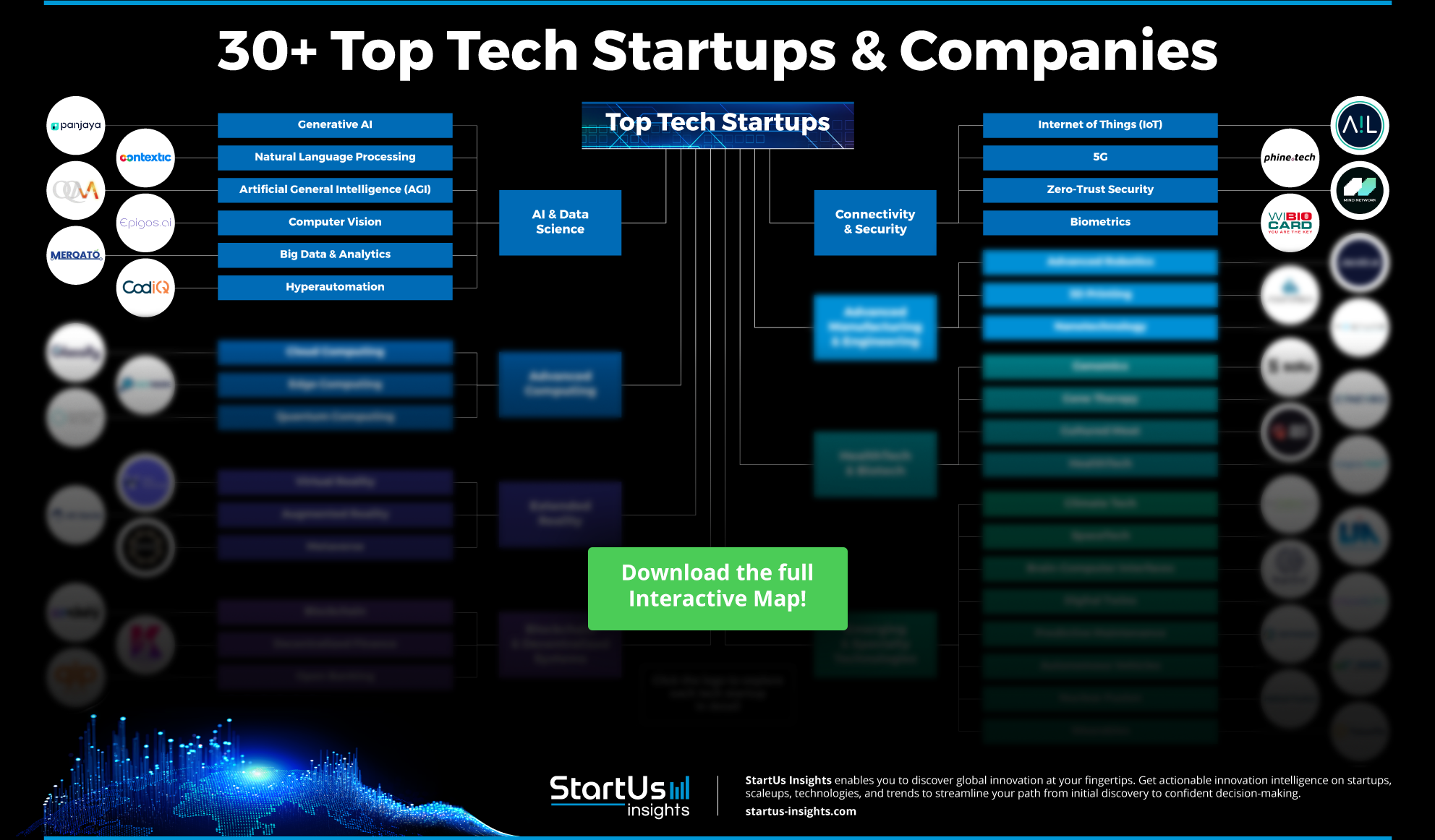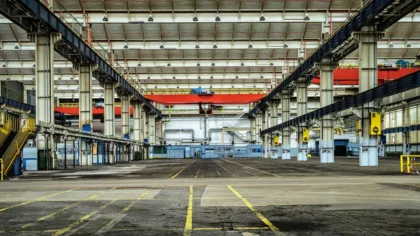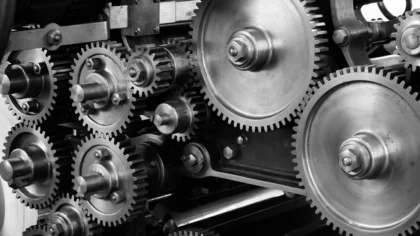The steel industry is leveraging artificial intelligence (AI)-driven predictive analytics, digital twins, blockchain, sensors, and hydrogen-based steelmaking to improve production speed, cost efficiency, and sustainability. For example, AI-powered furnace optimization reduces energy consumption, while digital twins enable real-time simulation of manufacturing processes to enhance efficiency and minimize waste. Stakeholders must incorporate these steel technologies into their operations, as the demand for greener, more efficient production methods increases.

Key Takeaways
- Additive Manufacturing
- Use Cases:
- Custom Tooling
- Economic Batch Production
- Rapid Prototyping
- Startup to Watch: SAAM
- Use Cases:
- Artificial Intelligence
- Use Cases:
- Quality Control
- Market Demand Prediction
- Energy Consumption Reduction
- Startup to Watch: MeghaAI
- Use Cases:
- Augmented Reality (AR) & Virtual Reality (VR)
- Use Cases:
- Safety Training
- Design & Visualization
- Process Simulation
- Startup to Watch: RoT STUDIO
- Use Cases:
- Big Data & Analytics
- Use Cases:
- Supply Chain Management
- Process Optimization
- Equipment Failure Prediction
- Startup to Watch: CloudForge
- Use Cases:
- Blockchain
- Use Cases:
- Product Traceability
- Inventory Tracking
- Smart Contracts
- Startup to Watch: DigiKerma
- Use Cases:
- CleanTech
- Use Cases:
- Waste Management
- Carbon Capture
- Water Conservation
- Startup to Watch: H2Electro
- Use Cases:
- Cloud Computing
- Use Cases:
- Resource Planning
- Remote Monitoring & Control
- Collaborative Work
- Startup to Watch: WiserSense
- Use Cases:
- Connectivity Technologies
- Use Cases:
- Machine-to-Machine (M2M) Communication
- Remote Operation
- Real-Time Data Sharing
- Startup to Watch: BeaconTrax
- Use Cases:
- Internet of Things (IoT)
- Use Cases:
- Equipment Monitoring
- Energy Management
- Inventory Management
- Startup to Watch: SenseLive
- Use Cases:
- Advanced Robotics
- Use Cases:
- Precision Manufacturing
- Quality Control Inspections
- Hazardous Environment Work
- Startup to Watch: OIYA Tech
- Use Cases:
Steel Industry FAQs
Which is the latest steel manufacturing technology?
- Hydrogen-based direct reduction replaces traditional carbon-intensive blast furnaces with hydrogen as a reducing agent to lower CO2 emissions.
- Electric arc furnaces (EAFs) using renewable energy melt scrap steel with minimal environmental impact.
- AI-powered furnace monitoring systems optimize energy consumption by continuously adjusting temperature and fuel input based on real-time data.
- 3D printing of steel components enables precise, cost-efficient production of complex parts with reduced material waste.
What is the future of steel innovation?
- Molten oxide electrolysis is a carbon-free process that produces steel using electricity instead of carbon-based fuels for a reduction in emissions.
- Laser-based manufacturing methods, including laser powder bed fusion, create steel components with complex geometries to enhance customization and reduce material usage.
- Smart factories enabled by IoT sensors and advanced robotics streamline production lines to improve factory performance and reduce asset downtime.
- The use of biochar as a carbon-neutral substitute for coking coal in steelmaking addresses the industry’s carbon footprint.
Where is this Data from?
StartUs Insights provides data through its comprehensive Discovery Platform, which covers 4.7 million startups, scaleups, and tech companies globally, as well as 20,000 emerging technology trends. The platform excels in startup and technology scouting, trend intelligence, and patent searches, offering a detailed view of the innovation landscape. For this report, we analyzed technologies within specific industries using the trend intelligence feature. During this research, we identified patterns and trends, pinpointing relevant use cases and the startups developing solutions for each. More capabilities and details are available at StartUs Insights Discovery Platform.
10 Emerging Technologies Impacting the Steel Outlook
1. Additive Manufacturing

Additive manufacturing (AM), or 3D printing, produces complex geometries layer by layer with minimal material waste. Technologies like laser powder bed fusion (LPBF) and direct energy deposition (DED) enable rapid production of steel parts. LPBF uses laser beams to selectively melt fine steel powder for creating highly detailed structures. On the other hand, DED repairs and produces large parts by depositing steel wire or powder directly where needed. These technologies enhance production flexibility and reduce lead times to create sustainable steel manufacturing processes.
3 Practical Use Cases of Additive Manufacturing in Steel
- Custom Tooling: AM produces specialized tools from digital designs to eliminate traditional tooling methods, improve the production process speed, and allow for greater design flexibility. This reduces lead times and production costs.
- Economic Batch Production: Small-batch AM reduces setup costs and material waste. Also, it allows steel manufacturers to respond to market demands quickly and improve overall operational efficiency.
- Rapid Prototyping: AM improves the design and development phases by creating and testing physical prototypes in a short amount of time. The technology iterates on designs, identifies potential flaws, and refines the products before full-scale production.
Startup to Watch: SAAM
Swedish startup SAAM produces supersized steel components for additive manufacturing. It combines traditional welding technology with advanced measurement, control, and analysis systems to create components while maintaining or improving material properties. The company uses in-house developed jigs and beds to produce complex shapes and rotationally symmetrical parts. The controlled and monitored manufacturing process reduces production time, ensures high material yield with minimal waste, and improves energy efficiency.
2. Artificial Intelligence

AI optimizes production and enhances efficiency with machine learning (ML), predictive analytics, and advanced automation. AI algorithms analyze production data in real time to enable smarter decision-making and the fine-tuning of processes, such as smelting and casting for consistent product quality. Moreover, AI-driven predictive maintenance reduces unplanned downtime by forecasting equipment failures based on sensor data for timely interventions. AI further optimizes energy use across production facilities and lowers both costs and emissions.
3 Practical Use Cases of Artificial Intelligence in Steel
- Quality Control: AI analyzes real-time production data to detect defects and inconsistencies early in the steelmaking process. This reduces waste, enhances product consistency, and minimizes rework while ensuring higher yields and better product reliability.
- Market Demand Prediction: ML algorithms optimize market demand prediction by analyzing historical sales data, market trends, and external economic indicators. This aligns production schedules with actual market demand, prevents overproduction, and reduces inventory costs.
- Energy Consumption Reduction: AI-powered systems continuously monitor energy use across production processes and recommend adjustments to optimize efficiency. By identifying energy wastage and fine-tuning operations, steel manufacturers achieve cost savings and lower carbon emissions.
Startup to Watch: MeghaAI
Indian startup MeghaAI develops a digital twin platform that uses AI and ML algorithms to provide real-time insights. The platform visualizes streaming and historical data to optimize steel plant operations, improve efficiency, and enhance decision-making. It integrates tools like anomaly detection, trending analysis, and custom key performance indicators (KPI) tracking to monitor asset health and operational performance. It also features a no-code AI interface for anomaly detection and Machine GPT for building custom models. Further, by offering a 3D digital twin and cloud-based rendering, the platform ensures high-speed data processing, even on low-end devices. This allows steel manufacturers to improve operational efficiency, reduce downtime, and increase productivity.
3. Augmented Reality & Virtual Reality

AR & VR enable real-time visualization of complex production processes to improve efficiency, precision, and decision-making. While AR enhances workforce training by simulating hazardous environments or complex machinery operations, VR provides detailed virtual models of production workflows. Additionally, the integration of AR and VR with data analytics and AI enables manufacturers to monitor production systems, identify inefficiencies, and optimize performance.
3 Practical Use Cases of AR & VR in Steel
- Safety Training: AR and VR enhance safety training by creating immersive, risk-free environments for workers to practice responses in dangerous situations, such as handling molten steel or operating heavy machinery. This increases hazard recognition and improves safety protocols while reducing workplace accidents.
- Design & Visualization: AR and VR allow engineers to create, modify, and interact with 3D steel structure models before they physically build them. This streamlines the design process and reduces costly design errors.
- Process Simulation: Simulating production processes in a virtual environment to test different configurations and troubleshoot potential issues improves efficiency and optimizes processes while reducing plant downtime.
Startup to Watch: RoT STUDIO
Turkish startup RoT STUDIO builds a VR training and design platform to create immersive scenarios without coding. The platform imports 3D object models to visualize and validate prototypes within interactive VR environments. Through its drag-and-drop methodology, the platform builds procedural training scenarios and offers an employee training solution. Its features include real-time model interaction, live measurements, customizable materials, and realistic lighting. This enhances design and training productivity in the steel industry.
4. Big Data & Analytics

The integration of big data and analytics solutions enables steel companies to better manage critical production data and leverage data-driven decision-making. Additionally, big data and analytics enhance demand forecasting and inventory management to optimize the supply chain. This reduces production costs, minimizes waste, and aligns production schedules with market demand.
3 Practical Use Cases of Big Data & Analytics in Steel
- Supply Chain Management: Big data and analytics track materials in real time, from raw steel to finished products, by consolidating data from multiple sources like suppliers, logistics, and production. This transparency optimizes inventory and allows steelmaking companies to predict potential delays in the supply chain.
- Process Optimization: Data analysis from various stages of steel production, such as casting, rolling, and heat treatment, identifies inefficiencies and optimizes parameters like temperature and speed. These insights improve product quality and cycles as well as reduce energy consumption to reduce operational costs.
- Equipment Failure Prediction: Advanced analytics solutions analyze sensor data from machinery to detect patterns that signal potential breakdowns. This predictive analysis minimizes unexpected downtime and allows for proactive maintenance to extend equipment life and ensure consistent production throughput.
Startup to Watch: CloudForge
US-based startup CloudForge automates and streamlines workflow management for metal service centers through its AI-driven cloud analytics platform. It enables real-time updates, smart search capabilities, and automated reordering to optimize stock levels and reduce costs. The platform also simplifies quoting and sales order management by automating fulfillment and speed to sale. With drag-and-drop scheduling, resource allocation, progress tracking, and real-time analytics, the platform further identifies trends, improves production scheduling and operations, and minimizes lead times.
5. Blockchain

By creating immutable records of transactions, blockchain enables steel manufacturers to track materials from raw sourcing to the final product and ensure accountability at every stage. This enables digital material passports for each product. Smart contracts further automate processes like payment settlements and compliance checks to reduce administrative overhead and improve operational efficiency.
3 Practical Use Cases of Blockchain in Steel
- Product Traceability: Digital ledgers record each stage of the steel production process to ensure the authenticity and quality of steel products. This provides the origins and compliance of materials.
- Inventory Tracking: Blockchain securely updates inventory transactions to securely monitor steel stock levels in real time across multiple locations. This improves inventory management, reduces overstocking or stockout risks, and enhances decision-making by providing reliable, single-source material availability data.
- Smart Contracts: Automate contract execution between suppliers, manufacturers, and customers to trigger payments or shipments based on predefined conditions without manual intervention. These self-executing contracts reduce administrative delays, increase operational efficiency, and minimize disputes.
Startup to Watch: DigiKerma
US-based startup DigiKerma develops CarbonKerma, a blockchain-based platform for trading carbon capture, utilization, and storage (CCUS)-derived carbon credits. The company captures carbon from steel manufacturing processes using CCUS and sequesters it in underground geological formations. Using blockchain, CarbonKerma tokenizes the captured CO2 into CarbonKerma Tokens (CKT). This way, CarbonKerma provides steel manufacturers with an auditable method to meet their decarbonization goals.

6. CleanTech

Cleantech integrates low-carbon technologies to reduce emissions and energy consumption. Innovations such as hydrogen-based direct reduction (H2-DRI) use green hydrogen instead of carbon-based fuels to lower CO2 emissions. Additionally, molten oxide electrolysis uses electricity to produce iron with zero direct emissions. Electric arc furnaces with renewable energy replace traditional blast furnaces to optimize energy efficiency and reduce the use of fossil fuels. These technologies improve the steel production processes to meet environmental regulations and market demand for green steel.
3 Practical Use Cases of CleanTech in Steel
- Waste Management: Cleantech reuses by-products, such as slag, dust, and other residues, to reduce waste sent to landfills. This improves sustainability and lowers disposal costs.
- Carbon Capture Systems: Replace carbon-intensive processes with real-time monitoring and automated adjustments to optimize energy use and minimize CO2 output. This approach enables low-carbon production models.
- Water Conservation: Closed-loop water systems recycle and reuse water during production processes to minimize freshwater usage and reduce wastewater discharge while lowering operational costs.
Startup to Watch: H2Electro
Estonian startup H2Electro provides high-temperature electrolysis cells (SOECs) to generate hydrogen through steam electrolysis for green steel production. These electrochemical cells use ceramic materials and operate at temperatures between 800°C and 850°C to improve electrical efficiency and leverage waste heat from industrial processes. The cells offer enhanced sulfur tolerance and strength against impurities as well as eliminate the need for precious metals. This reduces the overall operational costs.
7. Cloud Computing

Through cloud platforms, steel manufacturers manage vast amounts of production data in real time to optimize workflows, reduce costs, and improve supply chain management. Cloud-based systems provide access to data for predictive analytics, AI, and ML applications. Moreover, hybrid and multi-cloud strategies offer flexibility and optimal cloud environments while maintaining the resilience of various workloads and reducing risks. This way, cloud-hosted platforms streamline processes and enhance operational efficiency.
3 Practical Use Cases of Cloud Computing in Steel
- Resource Planning: Cloud computing centralizes data from production stages, supply chains, and market forecasts onto a single platform to adjust production schedules and resource allocation. This improves efficiency, reduces wastage, and provides real-time insights for resource management.
- Remote Monitoring & Control: Cloud-based systems collect and analyze operational data from connected devices and machinery across different facilities to provide remote access to critical system performance metrics. It manages production processes, reduces on-site supervision, and enables faster response times to operational issues.
- Collaborative Work: Cloud platforms enable the sharing of designs, data, and project updates among engineers, managers, and stakeholders across multiple locations. This enhances teamwork, improves decision-making, and provides access to the latest information.
Startup to Watch: WiserSense
UK-based startup WiserSense offers OOne, OTemp, OSound, ORev, and OGap, a suite of cloud-based real-time steel manufacturing monitoring products that improve operational efficiency and equipment health. These products continuously track vibration, shaft misalignment, motor temperature, acoustic anomalies, and more to prevent equipment failure and costly downtime. The products collect data from high-energy-consuming motors, electrical panels, and cardan shafts to offer insights into steel plant machinery. This reduces maintenance costs, extends equipment lifespan, and improves sustainability.
8. Connectivity Technologies

Connectivity technologies enable real-time data exchange to enhance operational efficiency. For instance, high-speed fiber optic networks ensure stable, low-latency communication between advanced automated systems, robotic arms, and digital control units to optimize real-time coordination in production environments. 5G-enabled private networks enhance connectivity for mobile and autonomous systems, such as unmanned cranes and autonomous maintenance vehicles, to improve flexibility and minimize human intervention in hazardous zones. Meanwhile, ultra-reliable ethernet networks offer synchronized communication between precision machinery to ensure tight process control in areas like rolling mills and casting units.
3 Practical Use Cases of Connectivity Technologies in Steel
- Machine-to-Machine Communication: Connectivity technologies allow equipment to exchange data and instructions without human intervention to optimize production workflows and ensure smoother, automated operations. This enhances efficiency, reduces manual errors, and improves overall production speed.
- Remote Operation: Connectivity solutions provide real-time access to plant machinery and systems to monitor and control processes from anywhere. It optimizes production schedules, predicts potential failures, and allows the implementation of preventative maintenance strategies.
- Real-Time Data Sharing: Allows different departments, systems, and stakeholders to access up-to-date information across multiple locations instantly. The continuous flow of data allows faster decision-making, enhances collaboration, and ensures prompt adjustments to improve production outcomes.
Startup to Watch: BeaconTrax
Canadian startup BeaconTrax builds a Bluetooth low energy (BLE)-based asset and worker tracking platform to ensure real-time visibility and operational efficiency across steel manufacturing facilities. The company’s BLE beacons interact with factory-wide gateways to enable precise location tracking and monitoring within production zones. Further, it platform collects real-time data on employee movement, equipment usage, and material flow to streamline operations and reduce downtime. This improves workforce productivity and security.
9. Internet of Things

IoT devices, including connected sensors and production equipment, gather real-time data from machinery and environmental factors. This data-driven approach enables predictive maintenance, enhances energy management, and improves operational efficiency. The integration of IoT with AI and cloud computing further delivers insights into production flows to optimize resource use and minimize downtime. Additionally, IoT networks allow for communication between different parts of the production chain to ensure better coordination, faster decision-making, and enhanced safety protocols.
3 Practical Use Cases of IoT in Steel
- Equipment Monitoring: IoT continuously captures real-time data to allow for predictive analytics. This approach minimizes unexpected equipment downtime, improves operational continuity, and reduces maintenance costs.
- Energy Management: IoT connects energy-intensive equipment and systems to offer detailed insights into power consumption patterns. These insights enable steelmaking companies to optimize energy usage in real time and during high-demand periods for reduced operational costs.
- Inventory Management: IoT-enabled devices monitor material flow to reduce lead times, improve inventory accuracy, and avoid costly interruptions.
Startup to Watch: SenseLive
Indian startup SenseLive offers an IoT platform for asset and machine monitoring to optimize operational efficiency and reduce downtime. The platform remotely connects to industrial assets for collecting real-time data on machine health, performance metrics, and energy consumption. This data enables predictive maintenance to service the machinery based on actual conditions rather than predetermined schedules. Its features include customizable alerts, a real-time performance dashboard, and asset oversight that provide insights into equipment status, maintenance needs, and potential failures.
10. Advanced Robotics

Collaborative robots (cobots), autonomous systems, and AI-driven robotics automate complex and hazardous tasks to reduce human exposure to dangerous environments and increase precision. These robots handle operations such as handling molten steel, quality control, and material transportation to improve productivity while minimizing errors. Additionally, AI-integrated robots analyze data in real time for predictive maintenance.
3 Practical Use Cases of Advanced Robotics in Steel
- Precision Manufacturing: Robots automate complex tasks such as cutting, welding, and shaping with accuracy. This enhanced precision reduces material waste, improves product consistency, and accelerates production timelines.
- Quality Control Inspections: Robotics equipped with advanced sensors and AI algorithms perform real-time monitoring and evaluation of steel products to detect surface defects and structural anomalies. This improves the accuracy and speed of inspections, minimizes returns, and reduces production costs.
- Hazardous Environment Work: In high-temperature furnaces or toxic areas, advanced robots replace human workers to reduce risk. This leads to increased workplace safety and reduced accidents while maintaining production supply.
Startup to Watch: OIYA Tech
Australian startup OIYA Tech provides advanced robotic automation systems to streamline processes such as material handling, assembly, and fastening. These systems use dual robotic setups and servo-controlled mechanisms to integrate with steel production lines for automating tasks, such as picking and placing beams, fastening screws, and handling materials. They enhance efficiency by minimizing labor costs, reducing safety risks, and ensuring high-precision execution. Their features include automated screw fastening systems and gantry robots, to optimize workflow while maintaining accuracy and speed.
Leverage Emerging Steel Technologies
Act now on the emerging technologies transforming the steel industry. With StartUs Insights, you swiftly discover hidden gems among over 4.7 million startups, scaleups, and tech companies, supported by 20,000 trends and technologies. Our AI-powered search and real-time database ensure exclusive access to innovative solutions, making the global innovation landscape easy to navigate.
Trusted by industry leaders like Samsung, Nestlé, and Magna, we provide unmatched data, a 360-degree industry view, and data-driven intelligence for confident strategic decisions. For instance, here is what Michael Skorianz, the Chief Technology Officer at Danieli Corus has to say about our platform, “By breaking down the megatrends into clear areas of development within our industry, StartUs Insights is able to give us valuable insights for refining our strategic direction. Paired with their commitment to deadlines, friendly, and attentive attitude our partnership is money well spent.”
Like this, leverage our innovation services to optimize costs, streamline operations, and stay ahead of the curve. Get in touch today to explore how our comprehensive innovation intelligence can drive your success.
Discover All Emerging Steel Insights, Technologies & Startups








